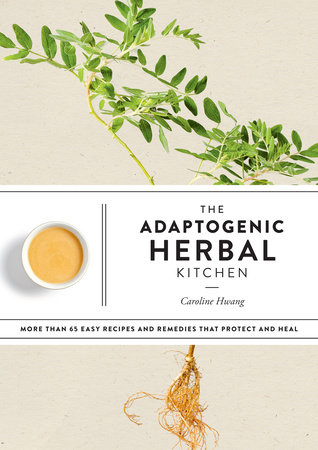Excerpt
The Adaptogenic Herbal Kitchen
Introduction We all live busy and stressful lives, and we all have responsibilities, endless tasks, and difficult emotions. Continuous stress can cause damage to our digestive, immune, and nervous systems, which in turn can present itself in forms of chronic pain, digestive issues, and weakened immune systems, among other issues. While managing stress is not an easy task, we can utilize strategies such as exercising, meditating, or going to therapy. Adaptogens present a unique way to restore balance and help your body manage stress. They are a non–toxic, non–habit forming, natural substance that protects against damage in the body caused by stressors. Adaptogens don’t reduce stress, but rather biologically increase the body’s capacity to handle physical, mental, and emotional stress. They adapt to the needs of the body in order to support optimal health. Adaptogens can also aid the body in other ways, such as increasing energy and libido, boosting immunity, and fighting depression and anxiety.
What are Adaptogens?Adaptogens have become very popular, but their roots are in traditional Chinese medicine and have been used for centuries. These herbal remedies come in the form of roots, herbs, and fungi. They can be easily used in tinctures, tisanes, smoothies, juices, and soups, as you will soon find. However, to make adaptogens effective, you must be consistent in taking them and treat them the same way you would a daily supplement. As with any supplement, always consult with a health professional before using them. Many of these can be bought online or at your nearest herbal/health-food store.
The Philosophy of Yin-Yang The philosophy of yin-yang is the basis of Traditional Chinese Medicine (TCM). For every yin there must be a yang, and if there is any imbalance, illness occurs. Yin and yang are constantly in flux. In TCM, there are four states: excess of yin, excess of yang, deficiency of yin, and deficiency of yang—and everything is connected.
In TCM, illnesses and diseases are not diagnosed based on symptoms but based on the Eight Principles, a group of four opposites, to bring the body back to balance. The Eight Principles are symbiotic opposites: yin and yang, excess and deficiency, heat and cold, exterior and interior. For instance, if there is a yang deficiency, it means there is an excess of yin (usually connected to cold), so herbs and adaptogens are used to warm the body and bring the yang up to balance the yin. Different adaptogens work to balance and tonify the body and its functions as well as create resistance to stressors.
How to use them Adaptogens can be used in a variety of ways. Make teas, tisanes, and tonics with them by using the roots; sprinkle powders into smoothies, juices, and soups; or use the whole root, such as ginseng, in soups and stews. If powders are a bit coarse, either strain the final product or grind into a finer powder with a spice grinder.
Extractions, ratios, raw form Adaptogens and medicinal herbs come in many different forms depending on where you get them from. You will notice that some come as extractions (i.e., 10:1 extract), which means that the manufacturers extract and isolate the medicinal compounds from the whole plant product. They extract the specific compounds that are believed to be the plant’s medicinal benefits, and each manufacturer has their own process of extraction. Other sources will provide the whole plant product, which includes all the natural properties. Make sure you take note of this when you calculate the dosage. In this book, the whole plant product dosage is used. If you use an extraction, use the dosage provided on the label.




